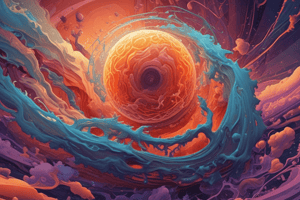Podcast
Questions and Answers
Which group of elements is highly reactive and have 1 valence electron?
Which group of elements is highly reactive and have 1 valence electron?
- Group 2A
- Group 3A
- Group 1A (Alkali Metals) (correct)
- Group 7A (Halogens)
Which element group has 8 valence electrons and does not have any charge?
Which element group has 8 valence electrons and does not have any charge?
- Group 4A (Carbon)
- Group 5A (Nitrogen)
- Group 6A (Oxygen)
- Group 8A (Noble Gases) (correct)
Which block of elements is mostly dense and hard?
Which block of elements is mostly dense and hard?
- Representative Elements
- Transition Metals (correct)
- Actinides
- Inner Transition
Which group of elements has 2 valence electrons and forms a +2 charged ion?
Which group of elements has 2 valence electrons and forms a +2 charged ion?
Which element group is designated with the letter 'A' and includes groups 1A to 8A?
Which element group is designated with the letter 'A' and includes groups 1A to 8A?
Which element group has a total of 7 valence electrons and forms a -1 charged ion?
Which element group has a total of 7 valence electrons and forms a -1 charged ion?
What is the unit used to measure density?
What is the unit used to measure density?
Which statement about matter is true?
Which statement about matter is true?
What is the triple point of pure water?
What is the triple point of pure water?
What is the difference between a liquid and a gas?
What is the difference between a liquid and a gas?
What is the relationship between the phases of matter and intermolecular forces?
What is the relationship between the phases of matter and intermolecular forces?
What is the difference between a vapor and a gas?
What is the difference between a vapor and a gas?
According to the kinetic molecular theory of gases, what is the relationship between the molecules in a gas?
According to the kinetic molecular theory of gases, what is the relationship between the molecules in a gas?
What is the relationship between the kinetic energy of gas molecules and the process of evaporation?
What is the relationship between the kinetic energy of gas molecules and the process of evaporation?
What is the purpose of liquefaction of gases?
What is the purpose of liquefaction of gases?
What was the contribution of J.J. Thomson to the understanding of the atom?
What was the contribution of J.J. Thomson to the understanding of the atom?
What was the main conclusion of Rutherford's gold foil experiment?
What was the main conclusion of Rutherford's gold foil experiment?
What is the relationship between the atomic number and the charge of an atom?
What is the relationship between the atomic number and the charge of an atom?
What is the relationship between the mass number and the subatomic particles of an atom?
What is the relationship between the mass number and the subatomic particles of an atom?
Flashcards are hidden until you start studying




